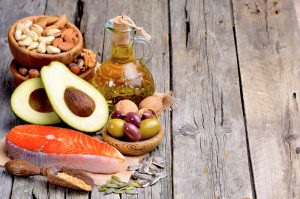
Eat fat to lose fat? Can it really be true…..?
The answer is yes…. with a catch!
Fat is a food group that has been demonised for years. So just what is fat?
There’s the fat that we consume and the fat, or energy, that is stored in the body for later use. Of the latter there are two types – short and long term storage. The longer term fat is the one we all detest and of course is the hardest to shift – hence the multi-million industry of fad and yo-yo diets!
So let’s examine the fat that we consume. Contrary to popular belief, the dietary fat we eat doesn’t necessarily turn to fat. In fact, fat has been wrongly accused over the past 40 years as the primary cause of heart disease and obesity. For many years we were recommended to choose low fat options (often ladened with sugar to make it palatable) and to reduce our cholesterol intake. Many people (including the scientists and health experts) did not realise that fat is a necessity and that cholesterol is essential for many bodily functions.
Have you ever tried to lose weight by eating a low-fat diet? Not easy right? In theory, fat has nine calories per gram, whereas carbs and protein have only four per gram, so experts say that in order to lose weight you have to avoid fat.
Makes sort of sense. But is that the truth?
Your fears may have some merit, as many fats in our supermarkets today are really just doing us more harm than good. Most meats, margarine, butter, popcorn, lard, vegetable shortening, fried foods, doughnuts, cakes, pizza dough and many more foods are overloaded with dangerous trans-fat and happen to be one of the leading causes our planet’s soaring obesity rate.
So, eating a low-fat diet by default means ALSO avoiding those foods, then of course it can really help you lose weight. But here’s the problem – your body does require the good fats in order to function properly. These fats play a role in everything from skin health, to your nerves and hormone production. Good fats facilitate the transportation of thousands of messages around the body – it is INFORMATION that is vital for the healthy functioning of our bodies. They also help reduce inflammation and promote healthy artery function for your heart… which is essential for, you guessed it, efficient fat-burning!
Let’s take a closer look.
Alongside protein, lipids and fats are the basic components of our bodies. We need to eat lots of healthy fats for brain health, heart health and skin health to name a few. About two-thirds of your brain is composed of fats and your entire nervous system relies upon it.
All our cells need good fat in order to function correctly. Approximately 20-30% of our dietary intake should be good fats. Note that’s a bit more than the food pyramid suggests, but it’s certainly a decrease on what we’re currently consuming – it is estimated that Australians are consuming upwards of 60% of total caloric intake from fats!
Not surprising we’re one of the fattest nations in the world.
Up until recently, we were recommended to eat more unsaturated (plant based) fats and less saturated (mostly animal based) fats. Saturated fats were demonised for elevating cholesterol (increasing the risk for heart disease) and we were advised to switch to unsaturated wherever possible. This has since been proven incorrect by a number of independent studies and prominent doctors worldwide.
Latest research indicates that there are many types of saturated fat, and not all are bad.
So just what is safe and nutritious from a fat point of view? There are 3 main types of edible fats;
1) Saturated – animal fats , butter, ghee, palm oil and some plant based fats (avocados and coconut oil)
2) Monounsaturated – olive oil, extra virgin olive oil and some nut oils (hazelnut, macadamia and almond)
3) Polyunsaturated – plant (vegetable and seed) based oils and Essential Fatty Acids (EFA’s)
There are some essential polyunsaturated oils that you must include in your diet everyday as the body cannot manufacture them – omega-3 and omega-6, known more commonly as Essential Fatty Acids (EFA’s). They are unstable by nature, so they must be stored in a cool environment and never heated. These EFA’s can be found in foods including nuts, seeds and fatty fish such as salmon, sardines and mackerel. These good fats fight inflammation, help to lower cholesterol and work to protect the heart from disease.
Omega-6 fatty acids are more easily obtained from diet (found in most plant foods) whilst omega-3 is found mainly in fish and seafood (hence the rise of foods fortified with omega-3 in recent years). The ratio of these types of fats is also important.
Our bodies require an omega-3 to omega-6 ratio of 1:2 for optimal functioning. What we are actually consuming is closer to 1:15 due to our over-consumption of cooking and salad oils, margarine and pre-packaged foods!
An imbalance of omega-6 to omega-3 causes inflammation in the body. Whilst inflammation is not always bad (this is one of our immune systems primary responses to infection), chronic inflammation is the major cause of all the degenerative diseases including heart disease, asthma, allergies, eczema, arthritis and cancer. Conversely, a healthy balance of omega-3 and omega-6 fatty acids will overall have an anti-inflammatory effect on the body.
So how to ensure we’re getting the right balance from the food we’re eating, without having to resort to supplements?
Choose foods that are as close to their natural state as possible, avoid processed foods, and ensure you eat fish 2-3 times per week. This will also ensure you get the right dose of EPA and DHA, contained in omega-3 rich foods. Both are important for a huge variety of functions in the body.
Saturated fats are the most stable of all the fats and are therefore the most suitable for cooking. Of the unsaturated fats, monounsaturated (olive and some nut oils) are more suitable for cooking as their structure is stronger and therefore less likely to be damaged during the heating process.
When cooking, choose a good stable fat such as coconut oil or olive oil (not EV, and be careful not to overheat) and for salads choose a good quality EV olive or nut oil – extra virgin cold pressed being the gold standard if you can afford it!
So instead of reducing fat, try to eliminate the bad fats (mainly animal based saturated fats) and instead choose good quality plant based saturated fats (avocado and coconut oils / butters) and monounsaturated oils (such as olive oil) for cooking and salads. If you enjoy butter on toast or bread then choose ghee or grass fed organic butter – it’s much better for you than the chemically produced margarine alternatives.
Remember, up to 20% of your total daily caloric intake should come from these healthy fats, so use abundantly and enjoy to your hearts (and waistlines) content!






